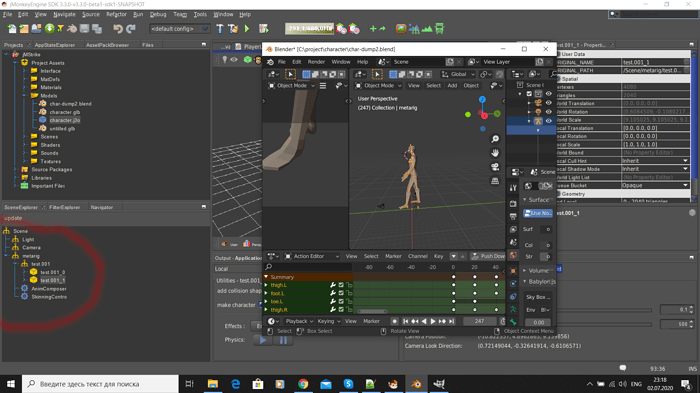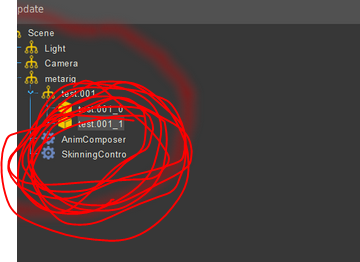package mygame;
import com.jme3.animation.AnimChannel;
import com.jme3.animation.AnimControl;
import com.jme3.animation.AnimEventListener;
import com.jme3.animation.LoopMode;
import com.jme3.app.SimpleApplication;
import com.jme3.asset.plugins.ZipLocator;
import com.jme3.bullet.BulletAppState;
import com.jme3.bullet.collision.shapes.CapsuleCollisionShape;
import com.jme3.bullet.collision.shapes.CollisionShape;
import com.jme3.bullet.control.CharacterControl;
import com.jme3.bullet.control.RigidBodyControl;
import com.jme3.bullet.util.CollisionShapeFactory;
import com.jme3.input.KeyInput;
import com.jme3.input.controls.ActionListener;
import com.jme3.input.controls.KeyTrigger;
import com.jme3.light.AmbientLight;
import com.jme3.light.DirectionalLight;
import com.jme3.math.ColorRGBA;
import com.jme3.math.Matrix3f;
import com.jme3.math.Quaternion;
import com.jme3.math.Vector3f;
import com.jme3.scene.Geometry;
import com.jme3.scene.Node;
import com.jme3.scene.SceneGraphVisitor;
import com.jme3.scene.SceneGraphVisitorAdapter;
import com.jme3.scene.Spatial;
import java.util.ArrayList;
/**
* This is the Main Class of your Game. You should only do initialization here.
* Move your Logic into AppStates or Controls
* @author normenhansen
*/
public class Main extends SimpleApplication implements ActionListener, AnimEventListener {
private Spatial sceneModel;
private Node playerModel;
private float rotationYOld;
private BulletAppState bulletAppState;
private RigidBodyControl landscape;
private CharacterControl player;
private Vector3f walkDirection = new Vector3f();
private boolean left = false, right = false, up = false, down = false;
private AnimChannel animChannel;
private AnimControl animControl;
//Temporary vectors used on each frame.
//They here to avoid instanciating new vectors on each frame
private Vector3f camDir = new Vector3f();
private Vector3f camLeft = new Vector3f();
public static void main(String[] args) {
Main app = new Main();
app.start();
}
public void simpleInitApp() {
/** Set up Physics */
bulletAppState = new BulletAppState();
stateManager.attach(bulletAppState);
//bulletAppState.setDebugEnabled(true);
// We re-use the flyby camera for rotation, while positioning is handled by physics
viewPort.setBackgroundColor(new ColorRGBA(0.7f, 0.8f, 1f, 1f));
flyCam.setMoveSpeed(100);
setUpKeys();
setUpLight();
// We load the scene from the zip file and adjust its size.
//assetManager.registerLocator("new-scene.zip", ZipLocator.class);
sceneModel = assetManager.loadModel("/Models/untitled.glb");
sceneModel.setLocalScale(2f);
playerModel = (Node)assetManager.loadModel("/Models/character.glb");
sceneModel.setLocalScale(0.2f);
rootNode.attachChild(playerModel);
playerModel.move(0, 0, 7f);
//playerControl.addListener( this);
/**
* ANIMATION
*/
animControl = playerModel.getChild("test.001").getControl(AnimControl.class);
animControl.addListener((AnimEventListener) this);
animChannel = animControl.createChannel();
//playerModel = assetManager.loadModel("Models/character.glb");
// We set up collision detection for the scene by creating a
// compound collision shape and a static RigidBodyControl with mass zero.
CollisionShape sceneShape =
CollisionShapeFactory.createMeshShape(sceneModel);
landscape = new RigidBodyControl(sceneShape, 0);
sceneModel.addControl(landscape);
/**
* We set up collision detection for the player by creating
* a capsule collision shape and a CharacterControl.
* The CharacterControl offers extra settings for
* size, stepheight, jumping, falling, and gravity.
* We also put the player in its starting position.
*/
CapsuleCollisionShape capsuleShape = new CapsuleCollisionShape(1.5f, 3f, 1);
player = new CharacterControl(capsuleShape, 0.05f);
player.setJumpSpeed(50);
player.setFallSpeed(50);
// We attach the scene and the player to the rootnode and the physics space,
// to make them appear in the game world.
rootNode.attachChild(sceneModel);
player.setSpatial(playerModel);
bulletAppState.getPhysicsSpace().add(landscape);
bulletAppState.getPhysicsSpace().add(player);
// You can change the gravity of individual physics objects before or after
//they are added to the PhysicsSpace, but it must be set before MOVING the
//physics location.
player.setGravity(new Vector3f(0,-30f,0));
player.setPhysicsLocation(new Vector3f(4, 12, 4));
}
private void setUpLight() {
// We add light so we see the scene
AmbientLight al = new AmbientLight();
al.setColor(ColorRGBA.White.mult(0.5f));
rootNode.addLight(al);
DirectionalLight dl = new DirectionalLight();
dl.setColor(ColorRGBA.White);
dl.setDirection(new Vector3f(2.8f, -2.8f, -2.8f).normalizeLocal());
rootNode.addLight(dl);
}
private void setUpKeys() {
inputManager.addMapping("Left", new KeyTrigger(KeyInput.KEY_A));
inputManager.addMapping("Right", new KeyTrigger(KeyInput.KEY_D));
inputManager.addMapping("Up", new KeyTrigger(KeyInput.KEY_W));
// inputManager.addListener(actionListener, "Walk");
inputManager.addMapping("Down", new KeyTrigger(KeyInput.KEY_S));
inputManager.addMapping("Jump", new KeyTrigger(KeyInput.KEY_SPACE));
inputManager.addListener(this, "Left");
inputManager.addListener(this, "Right");
inputManager.addListener(this, "Up");
inputManager.addListener(this, "Down");
inputManager.addListener(this, "Jump");
}
/** These are our custom actions triggered by key presses.
* We do not walk yet, we just keep track of the direction the user pressed. */
public void onAction(String binding, boolean isPressed, float tpf) {
if (binding.equals("Left")) {
left = isPressed;
} else if (binding.equals("Right")) {
right= isPressed;
} else if (binding.equals("Up")) {
up = isPressed;
} else if (binding.equals("Down")) {
down = isPressed;
} else if (binding.equals("Jump")) {
if (isPressed) { player.jump(new Vector3f(0,20f,0));}
}
}
@Override
public void simpleUpdate(float tpf) {
camDir.set(cam.getDirection()).multLocal(0.6f);
camLeft.set(cam.getLeft()).multLocal(0.4f);
walkDirection.set(0, 0, 0);
if (left) {
walkDirection.addLocal(camLeft);
}
if (right) {
walkDirection.addLocal(camLeft.negate());
}
if (up) {
walkDirection.addLocal(camDir);
}
if (down) {
walkDirection.addLocal(camDir.negate());
}
player.setWalkDirection(walkDirection);
cam.setLocation(player.getPhysicsLocation());
//Quaternion playerRotation = new Quaternion(walkDirection.x,walkDirection.y,walkDirection.z,0);
//playerModel.setLocalRotation(playerRotation);
//player.setPhysicsLocation(player.getPhysicsLocation());
playerModel.setLocalTranslation (player.getPhysicsLocation().x , player.getPhysicsLocation().y, player.getPhysicsLocation().z);
/**
* Rotation camera with chacarter
*/
float[] angles = new float[3];
cam.getRotation().toAngles(angles); // we get the cam angles here
angles[0] = 0; // you don't want to rotate along the x-axis, so we set it to 0
angles[2] = 0; // you don't want to rotate along the z-axis, so we set it to 0
playerModel.setLocalRotation(playerModel.getLocalRotation().fromAngles(angles));
//playerModel.setLocalRotation(q);
}
@Override
public void onAnimCycleDone(AnimControl ac, AnimChannel ac1, String string) {
throw new UnsupportedOperationException("Not supported yet."); //To change body of generated methods, choose Tools | Templates.
}
@Override
public void onAnimChange(AnimControl ac, AnimChannel ac1, String string) {
throw new UnsupportedOperationException("Not supported yet."); //To change body of generated methods, choose Tools | Templates.
}
}
jmonkey engine 3.2.4
null poiner exception at line
animControl.addListener((AnimEventListener) this);




